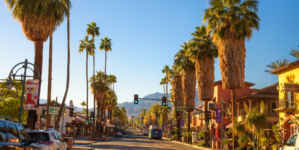-
How to Watch Arkansas vs. Murray State: Live Stream College World Series, TV Channel - 12 mins ago
-
Iran Has Sustained Blow After Blow Since October 2023 - 22 mins ago
-
Putin Says Americans ‘Galore’ Agree With Him - 47 mins ago
-
Trumps Promote American Bitcoin, a New Crypto Mining Venture - about 1 hour ago
-
Hundreds of Thousands of Americans Told Not to Burn Candles, Incense - about 1 hour ago
-
Sotheby’s to Auction a Ceratosaurus, With Millions and More on the Line - 2 hours ago
-
‘I have no fear’: L.A. Opera lovers attend shows in downtown L.A. despite protests - 2 hours ago
-
Woman Returns Home—Unprepared for What She Finds in Dog’s Bed - 2 hours ago
-
Mysterious Radio Signal Rising From Antarctica’s Ice Baffles Scientists - 3 hours ago
-
Pangolins Should Receive Endangered Protections, U.S. Officials Say - 3 hours ago
Contributor: Why California won’t give up the dream of high-speed rail
We have heard the stories and seen the headlines over and over: “Trump Administration to Pull $4 Billion in Funding for California High-Speed Rail,” “California’s high-speed rail project has ‘no viable path forward,’ new report says.”
In the face of constant negative prognostications and outright attacks by pundits and politicos of all stripes, how is it that California, like Sisyphus, keeps pushing such a giant boulder up an ever-growing mountain?
We have to admit that the history of our state’s high-speed rail has been disappointing, to say the least. The route has been planned, changed, argued over, compromised and hammered out over many years. Too many consultants were hired, too many lawsuits filed, too many hands have dipped into a governmental pot that looks like a get-rich scheme. The money stops and starts, which causes efficiency losses of all kinds, and it’s the ultimate political football, easy to kick by anyone with hatred of the “other side,” which seems to be all of us now. The final Environmental Impact Report has been approved after Herculean effort, construction is well under way, and yet many hurdles remain.
Despite the larger-than-life challenges, there are a few social issues that keep our state pounding away at this dream. Traffic is one of them. Californians clog their freeways up and down the state at nearly all hours. We subsidize highways to the tune of $32 billion a year, only to sit on them stewing. But we still love our cars, so would travelers give them up when going up and down the state? Apparently yes. In a recent survey, 54% of Californians still believe high-speed rail is worthwhile — suggesting that they would rather take a three-hour train trip than spend six to eight hours driving from San Francisco to Los Angeles. Besides the time savings for residents, it would cost roughly twice as much in new highway construction to provide the equivalent trip volume provided by high-speed rail, making it a financial win as well.
But aren’t there more pressing problems for California to worry about — like housing, for instance? Like most states, California faces an affordable housing crisis. Perhaps unintuitively, trains can help here as well. The decision to run the rail line through the Central Valley was deliberate. This is the area of the state with the least expensive land to develop, for housing and commerce. Just as the East Coast developed into a string of megacities linked by Amtrak, California is evolving into its own megalopolis. High-speed rail will not only connect these areas of housing and commerce but also will help produce them by reducing transportation issues. People will be able to commute by rail from affordable areas or live farther from urban centers without sacrificing access to urban amenities.
Another huge factor in the high-speed rail discussion is climate. Extreme weather events are growing worse, more frequent and more costly. More than 16,000 structures were destroyed in L.A.’s January wildfires, an astounding loss. The science of climate change is undeniably clear, and California is ground zero for the effects.
Transportation causes around 30% of the greenhouse gas pollution in the United States, and it’s one of the sectors where we have many known technologies to replace our polluting ways. High-speed rail is one of them. The efficiency of converting stored energy into electric train motion is incredibly high. It’s up to four times more efficient than driving cars and nine times more efficient than flying. And as we convert the grid to ever-cleaner sources of electricity, use of grid-sourced transportation like electric trains becomes cleaner as well.
The many reasons we need a modern rail system should keep us focused as we face obstacles. Remember that the Shinkansen in Japan, the Eurostar, the TGV in France and many other high-speed systems also went substantially over budget or were delayed during construction. Ultimately, they have been heavily used, and the results have been celebrated. The costs have been amortized over decades and proved to be totally worth the effort.
In the United States, we could get past much of the financial drama for high-speed rail if we considered creating a National Infrastructure Bank, which would rebuild our crumbling infrastructure and finance transportation projects like high-speed rail without adding to the national or state-based debt load. This common-sense financial mechanism built huge amounts of our national infrastructure in the past but currently faces headwinds because of self-destructive political polarization.
Climate, congestion, housing and commerce all help keep the dream alive, but perhaps there is something else brewing in California that just might make the dream real. We are the ultimate land of hope and solutions. This is still where dreamers dream and doers do, and we are stubborn about it. We see the political capture by entrenched, polluting profit seekers and it raises our ire. The success of high-speed rail in other countries raises our competitive hackles. The constant doom spread by media-driven conflict profiteers that use California high-speed rail to demonize things social in America makes us defiant.
Maybe all of these reasons have a multiplicative effect. Or maybe we simply refuse to believe that audacity, hope and pride in collective achievement is a thing of the past in the United States, and especially in California.
Jeffrey Beeman is a retired materials scientist and a member of Californians for Electric Rail.
Source link





















